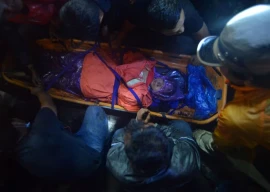
A volcano that erupted in southwest Iceland for the second time in less than a month, setting fire to several houses in a fishing town, appeared to be less active early on Monday.
"A black day" read the front page headline of Icelandic daily Morgunbladid across an image of bright-orange lava fountains and houses burning in the town of Grindavik, some 40 kilometres (25 miles) south-west of the capital Reykjavik.
Molten lava flows reached the outskirts of Grindavik around noon on Sunday, setting three houses alight, although the town was evacuated earlier and there was no immediate danger to people.
It was the second eruption on the peninsula of Reykjanes in four weeks and the fifth since 2021.
Live video footage on Monday showed glimpses of orange lava still flowing to the surface but at smaller volumes, and further away from the town.
Geologists on Sunday said magma corridors were believed to be flowing underneath the abandoned town, however, posing continued risk.
"Unfortunately (the lava) went a little bit more south than we had hoped for," the head of Iceland's Civil Protection and Emergency Management, Vidir Reynisson, told a press conference late on Sunday.
Read Iceland volcano erupts near town after weeks of quake activity
Nevertheless, the defensive barriers built to the north of Grindavik had helped divert the flows of lava to the west, away from the town, Reynisson said.
Residents of Grindavik, a town of some 4,000 people before it was evacuated in November, said it was difficult to watch televised images of the fires.
"This is serious, it's basically as bad as it can possibly get. Although it might get even worse, who knows," evacuated resident Jon Gauti Dagbjartsson told Reuters late on Sunday.
"I actually live in the house that I was born in and it's a tough thought to think that this town might be over, and I would have to start all over somewhere else. But if that's the case, then that's exactly what we'll do," he said.
The Icelandic government will meet on Monday to decide on support for the people of Grindavik.
"We need to put a lot of extra efforts into finding more housing, suitable housing," Prime Minister Katrin Jakobsdottir said.
Located between the Eurasian and the North American tectonic plates, among the largest on the planet, Iceland is a seismic and volcanic hot spot as the two plates move in opposite directions.

1732274008-0/Ariana-Grande-and-Kristin-Chenoweth-(1)1732274008-0-165x106.webp)



1732273396-0/Copy-of-Untitled-(72)1732273396-0-270x192.webp)
1732269802-0/Copy-of-Untitled-(71)1732269802-0-270x192.webp)
1732261957-1/Copy-of-Untitled-(66)1732261957-1-270x192.webp)


1732258132-0/BeFunk_§_]__-(26)1732258132-0.jpg)









COMMENTS
Comments are moderated and generally will be posted if they are on-topic and not abusive.
For more information, please see our Comments FAQ